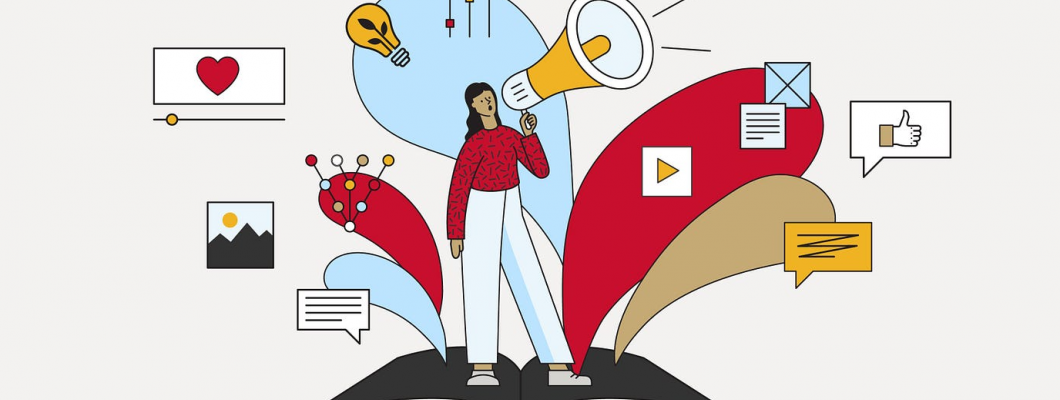
Introduction
In an age where users are overwhelmed by content and attention spans are shrinking, traditional communication no longer cuts it. That’s where visual storytelling comes in — the art of using design to communicate messages, evoke emotion, and spark action. From social media graphics to full-blown brand campaigns, storytelling through visuals is becoming one of the most powerful tools for designers and marketers alike.
What is Visual Storytelling?
Visual storytelling is conveying a narrative or message using visual elements — such as images, typography, colors, composition, and motion — instead of, or alongside, text. It allows designers to translate complex ideas into clear, engaging content that people can absorb quickly and remember easily.
Rather than simply decorating a page, visual storytelling puts strategy behind the style. It turns passive viewers into active participants by leading them through a journey, whether that journey explains a product, introduces a brand, or calls for social change.
Why Visual Storytelling Matters
Visuals are processed faster: According to research, the human brain processes visuals 60,000 times faster than text.
They improve retention: People remember 80% of what they see, compared to just 20% of what they read.
They enhance engagement: Posts with compelling visuals get far more clicks, shares, and conversions across digital platforms.
They transcend language: Imagery can communicate across cultures and literacy levels, making your message universally accessible.
Key Elements of Effective Visual Storytelling
To create visuals that truly speak, designers must thoughtfully combine several elements:
1. Narrative Structure
Like any good story, your visual content should have a beginning, middle, and end. It could be:
A transformation (before vs. after)
A process (step-by-step visuals)
A journey (e.g., brand evolution or user flow)
The narrative provides a sense of direction and cohesion to your design.
2. Characters and Emotions
People connect with people. Whether you’re showing a customer, a mascot, or an illustrated persona, humanizing your design can boost empathy and engagement. Facial expressions, posture, and color all play into this emotional connection.
3. Design Hierarchy
Use contrast, scale, and placement to guide the viewer’s eye. Ensure the most important parts of your message stand out first — whether it’s a call to action, headline, or product.
4. Color and Typography
Colors evoke specific emotions and help set the tone for your story. Typography also plays a huge role — not just in readability, but in mood. A bold sans-serif tells a different story from a delicate script font.
5. Consistency Across Platforms
Your storytelling should feel cohesive, whether it's in a banner ad, Instagram carousel, landing page, or explainer video. A unified visual language builds trust and recognition.
Visual Storytelling in Branding
Brands that use visual storytelling effectively don’t just advertise — they build relationships. They use design to express their mission, values, and personality in a way that’s instantly recognizable.
Examples include:
Apple: Minimalist design and emotive product videos.
Airbnb: Story-driven photography and inclusive illustrations.
Nike: Bold typography and high-contrast images that tell stories of perseverance and victory.
These brands show us that when visuals are rooted in story, they become memorable and meaningful.
Tools for Visual Storytelling
In 2025, designers will have access to a wide array of tools to bring stories to life:
Canva & Adobe Express – For quick, template-based visuals with storytelling impact.
Figma & Adobe XD – For designing interactive, narrative user flows and interfaces.
After Effects & Lottie – For animation and motion storytelling.
AI Tools (like Midjourney or DALL·E) – To generate story-driven imagery or prototypes faster.
Motion Graphics: Storytelling in Motion
Static images are powerful, but motion graphics add another layer of dynamism to storytelling. With subtle animations, transitions, or kinetic typography, you can:
Explain complex ideas
Highlight key features
Create more immersive user experiences
Motion gives you time and rhythm, letting you control the pacing of your message for greater emotional impact.
Practical Use Cases
Product Demos: Use visuals to show how your product solves a problem, not just what it does.
Data Visualization: Charts and infographics help translate data into digestible narratives.
Customer Stories: Use photography, quotes, and design to tell the story of real users.
Social Media Campaigns: Short-form visual storytelling (like Reels, carousels, or TikTok) captures attention quickly.
Website UX: Your site design can lead users through a journey, guiding them toward discovery, decision, or conversion.
Tips to Elevate Your Visual Storytelling
Know your audience: Tailor the tone, style, and content of your visuals to what resonates with your audience.
Don’t overload with visuals: Less is often more — let visuals breathe.
Use metaphors: A symbolic image can sometimes say more than paragraphs of text.
Test and iterate: A/B test different visuals to see what drives the best results.
Conclusion: Let Your Designs Speak
Visual storytelling isn’t just a trend — it’s a powerful method of communication that blends art, psychology, and strategy. As digital landscapes become more saturated, brands and creators who harness the power of compelling, clear, and emotionally resonant visuals will stand out.
By creating designs that don’t just look good but tell a story, you can captivate your audience, build deeper connections, and drive lasting impact.

Leave a Comment